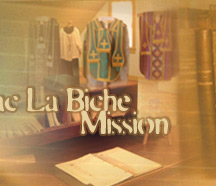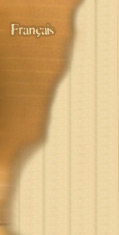






Education/Schools/Students | Nuns | Oblates
Domestic Services
| Sisters of Charity | Filles
de Jesus | Letters | Letters
2 | Life at Lac La Biche | Propagation
| Propagation 2
NUNS
Letters 2
Written by Mathildee Dancause f.j. (1949-1957) (1960-1963).
1949
-6 Daughters of Jesus
-50 boarders
-2 priests, 3 brothers, 2 employees would all come to the convent for meals.
Canning
We will help our Sisters with the canning of meats.
Of meats
Brothers brought some 50 chickens to the laundry. Chicken, building, I scalded them in a big pot and with the help of some boys, I feathered them as well. The feathers were used for comforters. The chickens were then brought to the kitchen to empty and wash.
Kichen
- Ice box with a chunk of ice on the top part (Ice was kept in a shack with sawdust). We could also keep the meat in there for some time.
- The boarders would help with peeling the potatoes and wash dishes.
- No running water and no sink in the kitchen.
- The dishpan water would be used to feed the pigs.
- We had 4 sinks in all, one in each of the children's dorm and one in the Nun's dorm.
When Sr. Chrysogone arrived she begged and received for the following: sink for kitchen, a tub for the Nun's and two showers for the children (this served approx. 50 people!)
1953 – Toilets, were installed inside! No more freezing in the outside toilets, but they were still used, outside, in the warmer weather!
Bathing
One of the Nuns would make divisions with grey blankets, the children would then wash their hair in basins that
were on a long dresser, then finish their bath behind the blanket division.
Heating
Two large wood stoves, I was in charge and had to get up during the night and in the a.m. at 5:20. I would empty the ashes, sometimes the log was too big for me and the stove!
Thank-goodness I had the help of Sr. Marie-Ann Plamondon, we had each our week to get up at 1:OOa.m. Still living, stoves would smoke a lot! After sometime we started heating with coal.
In 1952, Frere Tretreault took over the job.
On Monday mornings I also had to light the stove in the laundry and carry water to the convent to fill the large cauldron so I could start washing early. After breakfast the laundry building was not so cold, I could then open the water from the cellar and open the tap to the sink. Water would fall in a big reservoir, I believe it came from the Ste. Catterine's hospital. We had made a large opening on the top. Underneath we had put a pipe (or trough) with a tap. A large barrel received the water and we could connected a hose to the tap. When everything was full, we would shut the water leading to the laundry room and in the basement, I would then fill 5 large pails with the water that was still in the pipe.
Laundry was located near the convent (building feet: "demi- arpent").
Very cold, the walls and floor had only one row of boards and shingles, no insulation. There was a few holes I would cover with catalogues.
I had a washer that Frere Antoine had installed with the help of two metis. I also had a wringer, these two machines ran with a gas engine, there was a small reservoir of water to cool the motor. The water in the small reservoir would get hot and I would use it to wash, especially to boil, the white clothes. The top of the laundry room would be used to dry the clothes as I had two stoves in there. I would open the small window to allow the humidity to escape.
1953 – We used the basement of the school as a dorm.
We closed in 1963.
LETTER 3
Written by Ferrier, Thompson. Bibliography
Indian Education in the North-West (1873)
The truth is that the Indian has as distinct individuality as any type of man who has ever lived, and will never be
judged aright until we learn to measure him by his own standards, as we whites would wish to be measured if some more powerful race were to usurp (to seize or assume power, right, etc. wrongfully.) dominion over us.
To: Sr. Charlebois, Assistant General -General Hospital, Montreal.
From: Sr. Youville (Sr. de la Charite).
Hospice St. Joseph, Lac La Biche, 12 April, 1875.
- The entrance (or the parlor) served as a living room, the dorm, the dining room, laundry room, etc.
- Kept little stove red hot! The three ladies would open the door of the stove to fan the flames.
- Lots of fish to eat.
- A cross of 35' was placed by the lake.
- A Crop: 150 bushels of barley, 138 bushels of bad wheat.
- Small garden, very few seeds to plant.
- Chickens are still alive, we keep them in a building to keep them from the dogs mouths!
- We are so busy preparing clothing and food, etc., for the missionaries who are always leaving their own way.
- The hay is rare, the animals are thin. We are anxious for spring.
- Flour mill is brocken, bread will be scarse. The voyageurs bring very little flour.
© 2003 Société
culturelle Mamowapik and the Lac La Biche Mission Historical
Society (All Rights Reserved)
 |
 |
|
|
|
|
||||||||||||
|
|
|
|
|
 |
|
||||||||||||
 |
|
||||||||||||||||
 |
|
||||||||||||||||
| |
|
|
|
|
|
|
|
|
|
|
|||||||
 |
 |
|
|||||||||||||||
|
|
|
|
|
|
|
|
|
|
|
|
|
|
|
|
|
|
|